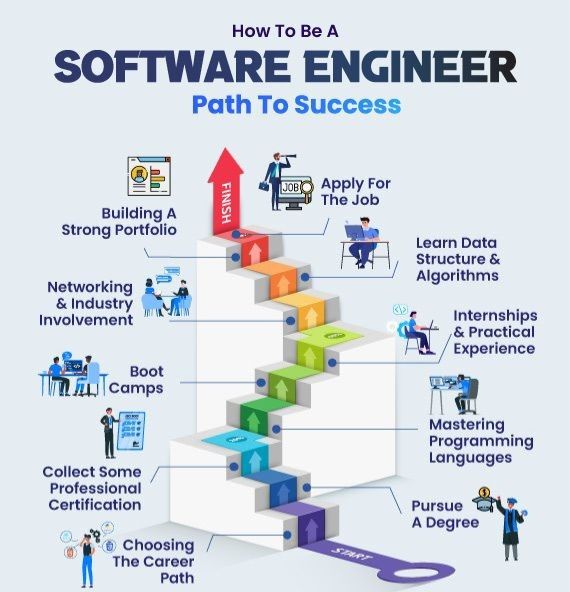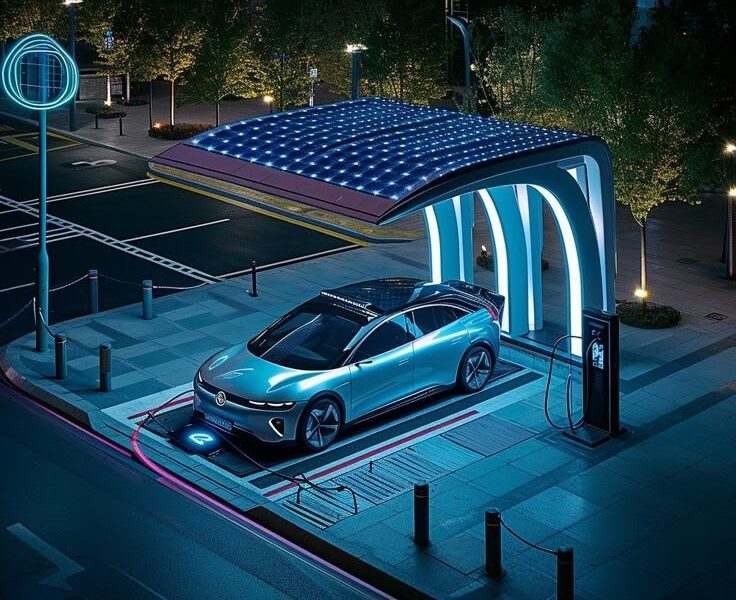## 🧠 **The Brain of Smart Vehicles: The Software-Defined Vehicle Revolution**
Innovations in software ecosystems within electric vehicles have fundamentally transformed the basic concept of vehicles, where cars are no longer merely mechanical devices but have become moving computers. The concept of Software-Defined Vehicles reflects that most of a vehicle’s functionalities are now controlled by software, not hardware. Over-the-Air updates have sparked a revolution in the vehicle’s lifecycle, where consumers no longer need to visit a dealer for improvements in vehicle performance, safety features, and infotainment systems. Artificial intelligence and machine learning algorithms have endowed vehicles with the ability to learn and adapt, allowing them to improve their performance according to the driver’s habits, route characteristics, and weather conditions. Deep neural networks have achieved exceptional accuracy in object detection and image recognition, which are fundamental for autonomous driving. Natural language processing has advanced voice commands and virtual assistants to such an extent that the driver can now control all the vehicle’s systems by voice. Real-time data analytics has accelerated and improved the decision-making process by collecting data from various vehicle sensors. Cyber-security protocols have provided protection for vehicle software systems against hacking and other cyber attacks. Cloud computing integration has made vehicles a vital part of the internet of things, enabling them to continuously exchange data with other vehicles, smart infrastructure, and cloud services. Distributed computing architectures have balanced the processing load by distributing complex computations across various electronic control units. Software validation and verification processes have ensured the reliability and safety of the software system. All these software innovations together are transforming electric vehicles into an intelligent and integrated mobility platform.

🔧 **Performance Optimization: Revolutionizing Energy Management via Software**
Software systems in electric vehicles have played a revolutionary role in energy management and performance optimization. Sophisticated battery management systems have improved battery life and performance by continuously monitoring its health, temperature, and charging cycles. Regenerative braking algorithms have increased the vehicle’s range by recapturing energy that would otherwise be lost during braking. Thermal management software has maintained the battery and powertrain components at an optimal temperature in extreme weather conditions. Predictive energy consumption models have provided the driver with accurate predictions of the remaining range. Route optimization algorithms have suggested the best routes to charging stations. Smart charging solutions have adjusted the charging rate according to grid demand. Vehicle-to-grid technology has transformed vehicles into mobile energy storage units. Energy distribution systems have balanced energy usage among different vehicle systems. Driver behavior analysis software has identified inefficient driving patterns and provided the driver with suggestions for better driving. Real-time diagnostics have detected energy waste immediately and resolved issues. All these software solutions together have taken the energy efficiency of electric vehicles to new heights.
🛡️ **Security and Safety: Advanced Protection Systems via Software**
Software systems in electric vehicles have radically changed the standards of security and safety. Advanced driver assistance systems have made driving safer through features like collision avoidance, lane keeping, and adaptive cruise control. Sensor fusion algorithms have provided an accurate picture of the environment by integrating data from cameras, radars, and lidars. Emergency response systems have automatically alerted emergency services in the event of an accident. Cybersecurity frameworks have secured vehicle networks from external threats. Over-the-air security updates have established a continuous system for patching vulnerabilities. Biometric authentication systems have prevented unauthorized access. Digital vehicle fingerprints have aided in theft prevention. Safety monitoring software has continuously assessed the health of vehicle components. Predictive maintenance algorithms have detected potential faults in advance. Remote diagnostics have promptly identified technical issues. All these software solutions together are making electric vehicles among the safest cars in the world.
🌐 **Connectivity: Continuous Communication via Software**
Connectivity software in electric vehicles has transformed them into an integrated mobility platform. Vehicle-to-Everything communication has given vehicles the ability to continuously exchange data with other vehicles, infrastructure, and pedestrians. 5G integration has enabled real-time communication through high-speed data transfer. Cloud connectivity has established a system for storing and analyzing vehicle data. Smartphone integration has provided users with the facility for seamless interaction with the vehicle. Remote vehicle control has given users access to various vehicle functions via mobile apps. Over-the-air feature activation has provided users with the facility to add additional features. Vehicle data analytics have provided manufacturers with valuable insights for product improvement. Connected navigation systems have provided real-time traffic updates and route optimization. Digital cockpit solutions have revolutionized passenger entertainment and productivity. All this connectivity software is making electric vehicles a crucial part of the smart mobility ecosystem.
🎮 **User Experience: Personalized Interface via Software**
Software systems in electric vehicles have radically transformed the user experience. Intuitive user interfaces have made interaction easy and enjoyable for drivers and passengers. Personalized profiles have memorized each user’s preferences and settings. Adaptive displays have optimized information presentation according to driving conditions. Voice recognition systems have provided hands-free control. Augmented reality dashboards have displayed essential information on the windshield. Entertainment systems have provided multimedia content for passengers. Gaming integration has turned charging periods into moments of entertainment. Wellness monitoring software has assessed the driver’s attention and well-being. Ambient lighting control has adapted the cabin atmosphere to the user’s preference. All these software features together are making the user experience in electric vehicles exceptionally attractive.
📊 **Data Analytics: Utilizing Data via Software**
Software systems in electric vehicles have played a significant role in the collection, analysis, and utilization of data. Vehicle performance monitoring has continuously reviewed operational data. Driver behavior analysis has studied driving patterns. Predictive maintenance algorithms have estimated the remaining life of components. Energy usage analytics have provided data for efficiency optimization. Traffic pattern analysis has aided in route planning. Charging behavior studies have provided insights for infrastructure planning. Software performance metrics have identified opportunities for system optimization. Customer preference analysis has guided product development. Fleet management solutions have provided data for commercial operators. Research and development have created databases for future technologies. All these data analytics software are becoming a source of continuous improvement for electric vehicles.
🔄 **Updatability: Continuous Improvement via Software**
The updatability of software systems in electric vehicles has increased the lifespan and relevance of vehicles. Over-the-air updates have deployed software improvements remotely. Feature activation has added new functionalities after sales. Bug fixing has resolved software issues. Security patches have addressed vulnerabilities. Performance enhancements have improved existing features. Compatibility updates have enabled integration with new devices. User interface improvements have enhanced the experience. New service integrations have offered additional value propositions. Regulatory compliance updates have adapted to changing regulations. Ecosystem expansions have enabled integration with third-party services. All these updatability features continuously improve electric vehicles over time.
🤖 **Autonomous Driving: An Autonomous Future via Software**
Software systems in electric vehicles have played a fundamental role in achieving autonomous driving. Perception algorithms have processed sensor data to create a map of the environment. Localization software has determined the vehicle’s exact position. Path planning algorithms have determined safe routes. Control systems have precisely controlled steering, braking, and acceleration. Machine learning models have developed decision-making capabilities in complex scenarios. Simulation platforms have enabled testing and validation. Safety assurance systems have established fail-safe mechanisms. Regulatory compliance software has met legal requirements. User interface software has established communication with passengers. Fleet management systems have managed the operations of autonomous vehicles. All this autonomous driving software is leading electric vehicles toward the future of transportation.
🔌 **Charging Integration: A Seamless Experience via Software**
Software systems in electric vehicles have made the charging experience smooth and enjoyable. Smart charging algorithms have optimized charging according to grid conditions. Route planning software has suggested the best routes to charging stations. Payment integration has enabled seamless transactions. Reservation systems have provided the facility to book charging stations. Energy management software has minimized charging costs. Battery preconditioning has improved charging efficiency. Remote monitoring has provided the facility to track charging status. Predictive analytics have forecast charging needs. User authentication has ensured secure access. Charging network integration has established compatibility with multiple providers. All this charging integration software is making the use of electric vehicles easier.
🌟 **Future Possibilities: New Dimensions via Software**
Software systems in electric vehicles have opened new dimensions for the future. Artificial general intelligence has created the capability for complex decision-making. Quantum computing has increased computational power. Blockchain integration has enabled secure transactions. Digital twin technology has advanced virtual testing and simulation. Brain-computer interfaces have created the possibility of direct neural control. Swarm intelligence has improved vehicle coordination. Emotional AI has incorporated emotions into human-vehicle interaction. Holographic interfaces have revolutionized display technology. Self-healing software has increased system reliability. Ethical AI frameworks have ensured responsible AI use. All these future software possibilities are keeping electric vehicles on a path of continuous evolution.


